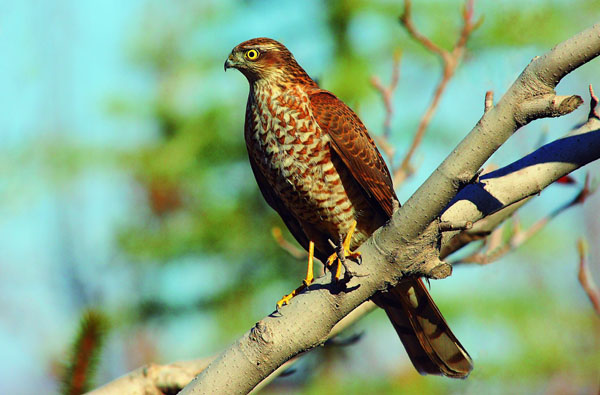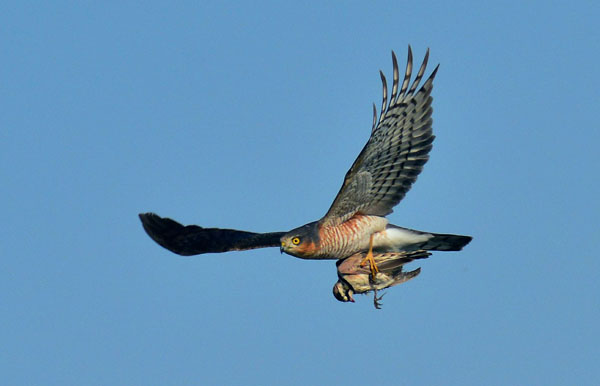Accipiter nisus
IUCN
LCBasic Information
Scientific classification
- name:Accipiter nisus
- Scientific Name:Sparrowhawk, Yellow Hawk, Harrier Hawk
- Outline:Raptor
- Family:Accipitriformes Accipitridae Accipiter
Vital signs
- length:30-41cm
- Weight:130-300g
- lifetime:20~30year
Feature
Hawks are the best mouse catchers
Distribution and Habitat
It breeds in the northeast, northern North China and parts of the southwest, and has records of wintering in most parts of China. It is distributed in Eurasia abroad and extends to the northwest of the African continent. It winters in the Mediterranean, West Asia, South Asia and Southeast Asia.
It likes to move around in forest edges and open woodlands. Its natural breeding grounds are in mixed pine and cypress forests, and it rarely nests in broad-leaved trees. Now more and more nests are set up near towns. In winter, they usually choose more open rural areas and leave the woods, and can often be seen in parks preying on songbirds, and the predation process is usually more intense.
Appearance
The body is medium to small, and the female is obviously larger. Six wing fingers can be seen when this species is flying. The white chest and abdomen are densely covered with light red or brown fine horizontal stripes, which are similar to goshawks, but the body is smaller, the neck is shorter, and the tail is longer.
The back of the female bird of this species is brown, and the male bird can be distinguished by the blue-gray back and reddish "cheeks". The lines on the chest of immature birds are slightly chaotic, and there may also be some vertical lines. Many individuals have more obvious white eyebrows than adults.
When it is landed, it can be observed that the throat of this species is densely covered with fine vertical lines, thin legs, and long middle toes.
Details
The sparrowhawk is a common forest hawk and an expert in preying on small birds. The sparrowhawk flies quickly and at extremely high speeds, reaching hundreds of kilometers per hour. It flies powerfully and nimbly, and can fly skillfully between trees. It usually flaps its wings quickly for a while and then glides for a while. It usually does not mix with other birds of prey during the migration period, but two of this species can be seen flying together. Its diet is mainly small passerine birds, insects and rodents. There are also records of preying on slightly larger birds such as pigeons and three-toed quails, and sometimes squirrels and snakes. Among the food of the sparrowhawk, 5% is insects, 15% is birds, and 80% is rodents, so it can be said to be an expert mouse catcher among hawks.

Some sparrowhawks are resident and some are migratory. They migrate to their breeding grounds in spring from April to May and leave their breeding grounds in autumn from October to November. Sparrowhawks enter their breeding season in May every year. At this time, the male birds call frequently and loudly, often flying in the air while calling. Male and female birds sometimes hover over the woods, and sometimes shuttle between the woods, chasing and playing with each other. Mating mostly takes place on the flat branches of coniferous or broad-leaved trees. Usually, the female bird stands on the branch, stretches her neck and turns her head, looking around, watching the movements of the female bird, and calling a few times from time to time. Then the male bird comes to its side, jumps on the back of the female bird, and spreads its wings to keep balance. The female bird lifts its tail feathers, and the tail feathers of both parties swing left and right, making cheerful calls, completing the mating. After mating, the male bird flies to another branch, shakes its body, and loosens its feathers; the female bird sometimes stays in place, and sometimes follows the male bird.

The breeding season is from May to July. Nests are built on trees in the forest, 4-14 meters above the ground. The nest is usually placed on a branch fork close to the trunk. They often build nests on medium-sized broad-leaved or coniferous trees such as lindens, red pine trees or larch trees, and sometimes use other bird nests to supplement and repair them. The nest area and nest are relatively fixed and often used for many years. The nest is disc-shaped, mainly composed of dead branches, with spruce twigs and fresh leaves such as tamarisk and euonymus.
Sparrowhawks are widely distributed and have a large number. In particular, they prey on a large number of rodents and pests, which is very beneficial to agriculture, forestry and animal husbandry, and also plays a positive role in maintaining ecological balance. Sparrowhawks can be domesticated as hunting birds.








